To celebrate Back-to-School, whatever that means to you during this eternal global pandemic, I’ve been exploring school lunch menus and books to get an idea of what was served to the kids of the past. I’ve found some fantastic resources and some pretty unusual recipes, some of which you can see in my previous post Vintage School Menus and Recipes (1916-1960).
My personal favorite resource is “The Rural School Lunch” (1916) written by Nellie Wing Farnsworth, Director of Home Economics at a state teaching college. In case you’re wondering, teaching schools used to be called “Normal” Schools.
The Rural School Lunch was designed to help rural schools develop a “warm noon lunch” program with limited resources. They said it couldn’t be done but Nellie Farnsworth proved them wrong!
School lunch programs have been around in the United States in some form since 1853, particularly in boarding schools, but it wasn’t all that common. Prior to 1905, most Urban schools would send kids home to eat with their families. But in 1916 warm lunch was still rarely served in smaller schools with fewer staff and children. At this time, kids would typically bring their own basket lunches or just go home to eat depending on how far they lived from the schoolhouse.
This book covers everything from nutrition and equipment to table manners and dealing with naughty or “incorrigible” children who won’t eat. While there are no sample daily or weekly menus in the book, there is a list below of dishes “suitable” for being served to children at school. It appears that the ideal lunch would have been a beverage and one warm lunch item supplemented by the cold lunch items brought from home. The kids would help prepare the warm lunch whenever possible, and would help clean up. The author specifically mentions – more than once – that the boys are to be just as involved with this entire process as the girls.
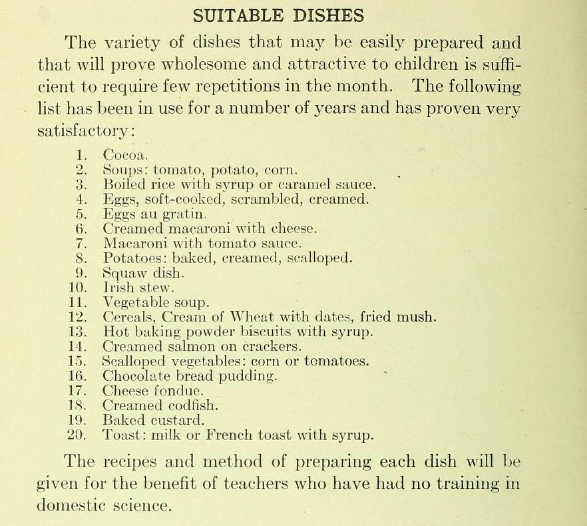
I enjoyed the book so much I was inspired to make both a 1916-style cold lunch basket and a simple warm lunch using a few of the recipes. For the purposes of this project I chose two breakfast-themed dishes that worked well together (though they likely wouldn’t have been served together) and a warm cocoa. The basket lunch contains items also suggested by Farnsworth.
The Recipes
Basket Lunch
A typical basket lunch would include a plain sandwich with jam, egg salad or dates and nuts. Graham or white bread was considered to be the best nutrition-wise. Some of the sides would be a piece of fruit (like an apple or other locally grown item), custard or jelly. The desserts would be little cookies or biscuits and a few lumps of sugar. Each child was encouraged to bring a cloth napkin with his/her name or initials sewn into the corner.
The author notes that not all children bring wholesome meals from home, which is why she encourages schools to provide a warm menu item and specifies the items in the basket should be viewed as supplementary to the noon meal.
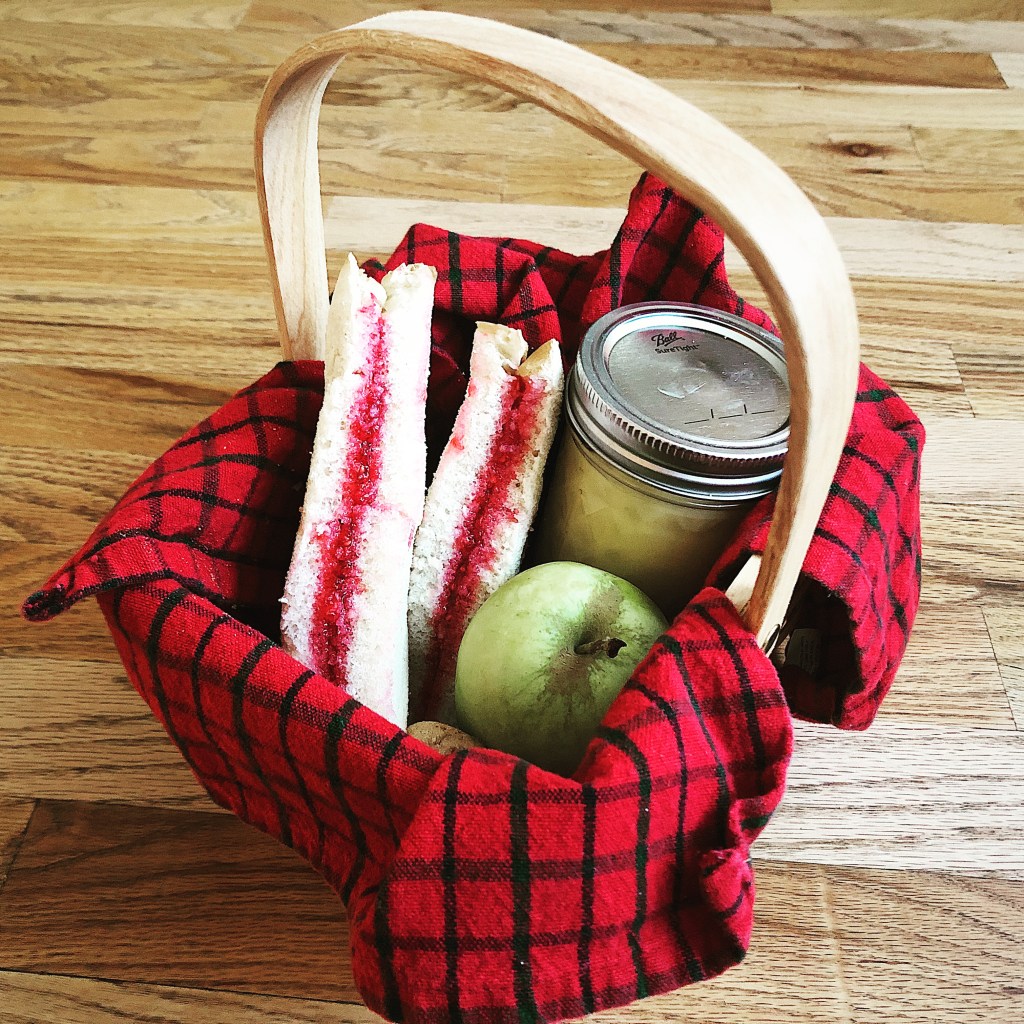
Warm Lunch
It was considered important at the time for children to eat something warm during the day, not just during the Winter for obvious reasons, but because the heat was believed to aid in digestion and provide much needed energy. In fact, there is a lengthy list of reasons Farnsworth believed children benefited from having a warm noon meal together at the school rather than at home.
All of the recipes in this book are intended to be inexpensive and easily prepared. Some food items were to be prepared the night before, but many could be made over a simple stove right in the school house. The food would have been served on regular flatware and washed daily. Napkins were typically cloth and brought from home, but the author suggests looking into getting paper napkins, which didn’t cost much to purchase in large quantities.
Cocoa
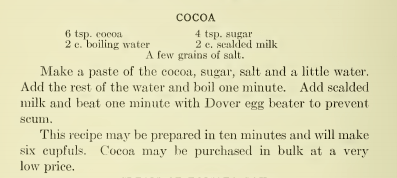
Ingredients:
- 6 tsp. cocoa
- 2 cups boiling water
- 4 tsp. sugar
- 2 cups scalded milk
- A few grains of salt.
Make a paste of the cocoa, sugar, salt and a little water. Add the rest of the water and boil one minute. Add scalded milk and beat one minute with Dover egg beater to prevent scum. This recipe may be prepared in ten minutes and will make six cupfuls. Cocoa may be purchased in bulk at a very low price.
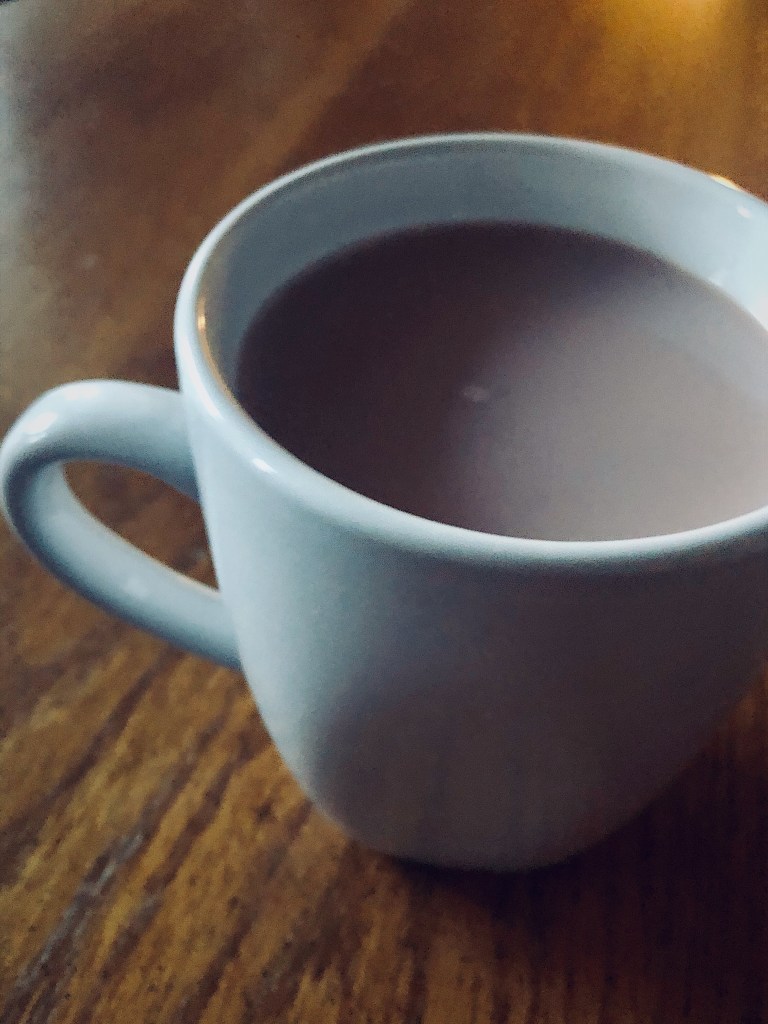
The recipe is pretty self explanatory, but I’ll go over a few things:
- Make the paste with the cocoa, sugar and salt in the same pot you plan to heat up the cocoa because it doesn’t transfer well from a bowl. When adding water to moisten the paste, take water away from the 2 cups set aside for boiling. This is important because it might make it too watered down otherwise.
- Add the rest of the water and bring to a boil. Meanwhile, scald the milk in a separate pot. This just means heating it up to just under a simmer. These detailed instructions might help.
- Add the scalded milk to the pot and use a whisk. You can use an egg beater if you want, but the whisk worked just fine.
- Add a little more sugar or cocoa to taste, if desired.
This old-fashioned cocoa is pretty good. It is not nearly as sweet or as rich as modern commercial hot chocolate. I didn’t need six cupfuls so I just halved the recipe.
Cream of Wheat with Dates

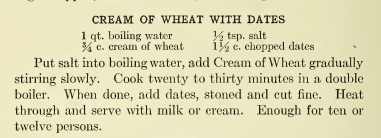
Ingredients:
- 4 c. boiling water
- 3/4 c. cream of wheat
- 1/2 tsp. salt
- 1 1/2 cup. chopped dates
Put salt into boiling water, add Cream of Wheat gradually stirring slowly. Cook twenty to thirty minutes in a double boiler. when done, add dates, stoned and cut fine. Heat through and serve with milk or cream. Enough for ten or twelve persons.
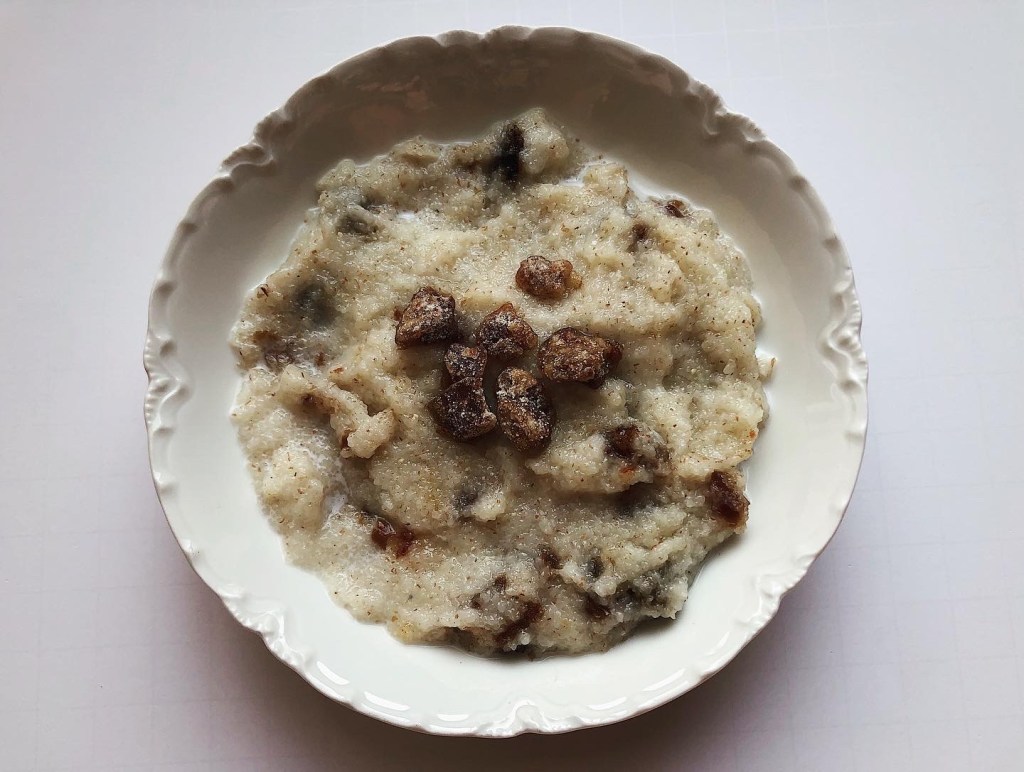
This is one of those recipes that really can’t be replicated exactly for one major reason: Modern Cream of Wheat is just not the same as it was in 1916.
In the early days of the product it generally took 20 minutes to make! Up to 30 if cooked in a double boiler as this recipe directs. But now with the removal of much of the roughage/fiber, the highly enriched “instant” product is made in a much shorter time. If you’re lucky you might find a box of 10-minute Cream of Wheat, which will be more wholesome and thick than the 1 minute or 2 1/2 minute variations.
- I strongly suggest following the directions on the back of the Cream of Wheat box. If you can find a 5 or 10-minute version, do that!
- Add chopped dates and heat through.
- You can serve it thick as is, or add milk or cream.
Verdict: If you like Cream of Wheat you’ll love this! It’s warm and savory, balanced out by the added milk/cream and sweetness of the dates. Cream of Wheat is among my least favorite foods- mostly due to texture – but the dates made it palatable.
Creamed Eggs and White Sauce
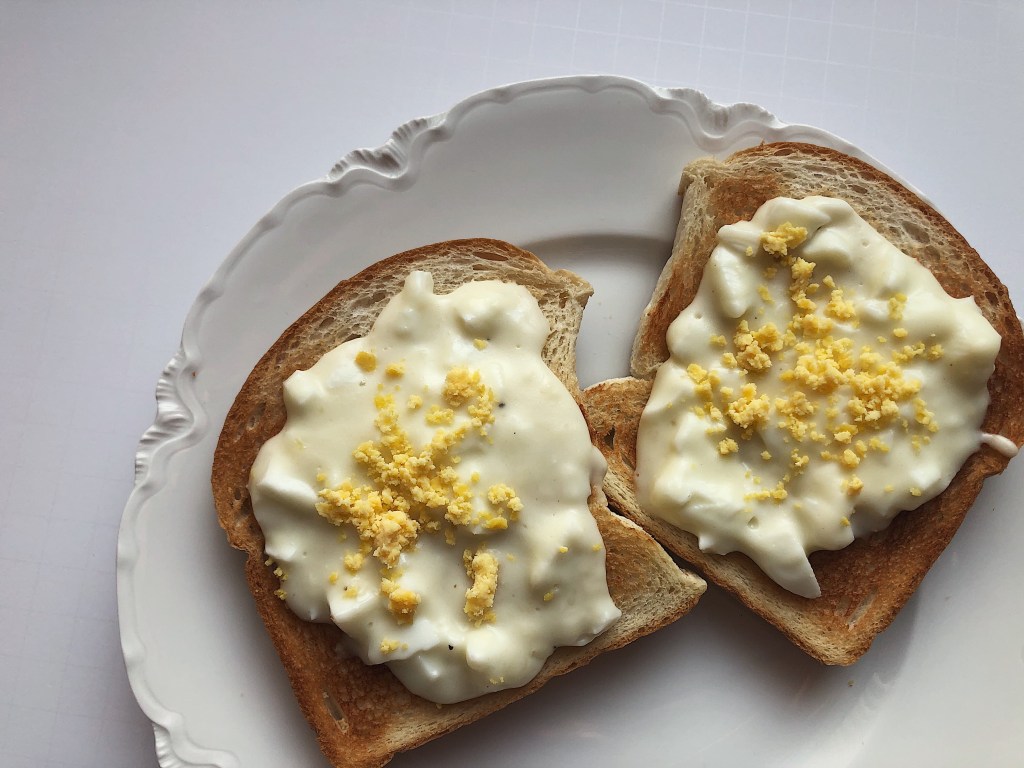


- 6 eggs, hard cooked
- 1 1/2 tbsp. butter
- 1 1/2 tbsp. flour
- 1/2 tsp. salt
- 1 c. milk
- pinch of pepper
Rub together butter, flour, salt and pepper. Add milk slowly and cook til thick, stirring constantly.
Use hard-cooked eggs that have been in boiling water for 30 minutes. Remove shell, cut through center and remove the yolks. Put yolks through a sieve, mashing them to a fine powder. Cut the whites into small pieces. Add whites to white sauce and heat through, serve on crackers or toast and cover lightly with the powdered yolk. Allow one egg to a person.
- Shell the hard-cooked eggs and cut them in half. Remove the yolks and crumble or mash them into a powder. Cut the whites up into small pieces.
- Combine butter, flour, salt and pepper. Add the milk slowly and cook until it thickens, being sure to stir constantly.
- When the sauce is thick, add the egg white pieces and heat through.
- Serve the sauce on toast or crackers and sprinkle egg yolks along the top.
Verdict: I was a little wary about the creamed eggs, to be honest. The sauce smelled like hot milk and looked unappetizing at first. However, I tried it on a piece of toast and genuinely enjoyed it! The sauce is savory and flavorful, almost like an egg gravy. The egg whites add a bit of lumpy texture to it and the yolks sprinkled on top were delicious. I’d make creamed eggs again!
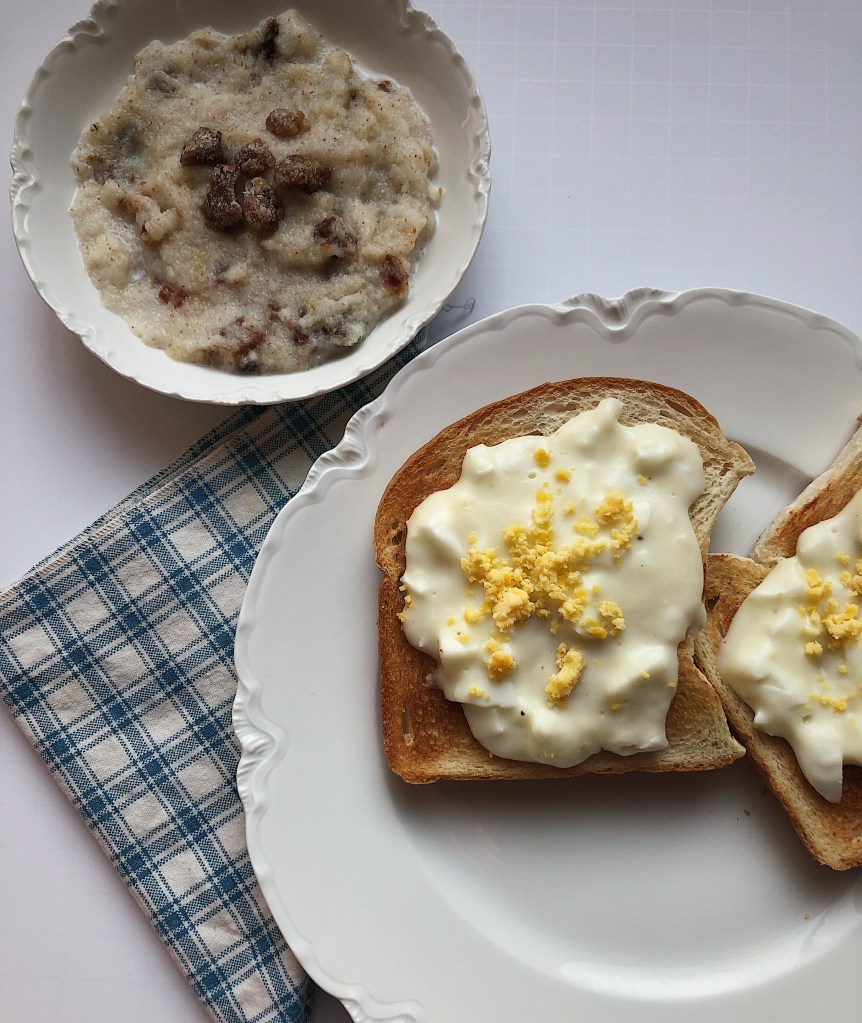
Overall, I’m impressed with the quality of this simple 1916-era school lunch. It is far from fine dining, but the recipes are very easy and quick to make and the ingredients are very inexpensive.
I haven’t eaten a school lunch for 20 years, but I can tell you now that the food served in the lunchroom when I was young just wasn’t real food. It was greasy and generally unhealthy, though we would always have celery or carrots with it. I would often wrap my “pizza” and burritos in napkins before eating because all the grease and oil dripped into my lap or made me sick!
This vintage meal, however, tastes like something grandma would make for breakfast. It’s really a home-cooked meal intended to be whipped up over the stove in a little rural schoolhouse. There are some other great recipes in this book that I may get to someday, but in the meantime, if any of you foodies or history hobbyists want to give them a shot be sure to let me know how it goes!
Hi! I love your recipes, Thanks for sharing this post I appreciate your great effort in bringing all the tips together in the single post
selfkitchen4u
LikeLike
Thanks so much!
LikeLiked by 1 person
I’ve never had cream of wheat for lunch. In my mind, it’s a breakfast dish. My mother cooked it in the 1960s-70s and served it with a small pour of condensed milk on top.
LikeLiked by 1 person
It was a breakfast dish for me too! I couldn’t stand it though so I wouldn’t eat it when I was young. Condensed milk sounds interesting, I’ll have to try that.
LikeLike
I just found your site, and just by reading this post I can firmly say that I love what you’re doing here! I’m so excited to keep exploring your website.
LikeLiked by 2 people
Thank you! I’m so glad you enjoy my content!
LikeLike
I love these recipes and your explanation of them Sarah, each one is so detailed and insightful. The creamed eggs looked yum I am glad they tasted good. I wish I could have taken my lunch to school in a basket like this, what a nostalgic trip!
LikeLike
Why thank you! No reason you can’t start packing your lunches in a little basket. Why not?
LikeLiked by 2 people
I might be seen as a bit twee and odd in my workplace if I do this haha. If I put my hair in pigtails I will just say it’s fancy dress or a cosplay hehe. But I think would get away with it for a picnic!
LikeLiked by 2 people
haha!
LikeLiked by 1 person
Great post! I love all your recipes! Will definitely add them to my notes!
LikeLike
Thank you Leif!
LikeLike
Good afternoon! Just to let you know, I nominated you for The Liebster Award. Should you want to accept, here are the “rules.” (For the official rule language, visit the Liebster Award site, https://theglobalaussie.com/the-liebster-award/ ) — Thank the person who nominated you, and include a link to that site. Write an acceptance post including the Liebster logo. Answer the questions posed in the nomination. Nominate as many others as you’d like for the Liebster Award, ask them questions, and let them know you’ve nominated them. You may also wish to visit the Liebster Award page and leave a comment. That’s it!
LikeLiked by 1 person
Awe thanks for nominating me! This is so flattering and it brightened my day!
LikeLiked by 1 person
I just came across your blog today and I have to say it is so interesting. I am eager to what else you explore and share with us.
LikeLike
Thank you so much! Glad to have you here!
LikeLike
Historical cooking and the changing standards and values associated with cooking and nutrition have always fascinated me. I’m so glad I just found this blog!
LikeLiked by 1 person
Glad to have you here!
LikeLiked by 1 person
Oh wow, this definitely looks a bit different from what we get now. Though actually the food sounds pretty good.
LikeLiked by 1 person
This was a fun interesting post to read with a lot of history and information. Thanks for sharing it with us.
LikeLiked by 2 people
Id like to see today’s American schoolchildren eat creamed salmon on crackers!
LikeLike
lol! They wouldn’t touch it.
LikeLike
This is really my favorite blog of all time. Thank you for all of the work and research you put in!
LikeLike
Oh this makes me so happy!! I’m glad you’re enjoying my work. 🙂
LikeLike
I love the way you write. It’s so clear and easy to understand.
And what a great article by the way!
LikeLiked by 1 person
Thank you!
LikeLike
We would get cream of wheat for lunch with some unsweetened cocoa powder, sugar and a pat of butter mixed in. I think my grandma also cooked it with milk….I really want to try the creamed eggs on the next gloomy rainy day.
LikeLike
That sounds not too bad! I’ve never thought to add cocoa powder.
LikeLike
Lovely recipe; felt like eating your images; lol. Thats a superb dish.
LikeLike
Thank you!!
LikeLiked by 1 person
Interesting post. In the book I just finished they talked about a small- scale school lunch program just like this in WA state during the 1930s. It sounds like the may have used this book–Hot cocoa as “lunch” even! If interested [no pressure] here is the book https://hopewellslibraryoflife.wordpress.com/2020/11/02/nonfiction-november-review-the-food-of-a-younger-land-by-mark-kurlansky/
LikeLiked by 1 person
Looks like an interesting book! Thanks for sharing. 🙂
LikeLiked by 1 person
Interesting read. I grew up with School lunches in Britain in the ’60’s. I still have nightmares 🙂
LikeLiked by 1 person
This was interesting.
LikeLiked by 1 person
This is truly fantastic! Loved you combination of recipes and the research done!
LikeLiked by 1 person
I grew up on creamed eggs. I recall liking it.
LikeLiked by 1 person
I was searching for what might be in a 1925 lunchbox carried to a rural school. Your article was most helpful! I interpret the 1925 school at a state park. When we have classes come through the school, we first enter into the ante room or cloak room. There on a shelf are the tin lunch boxes, everything from tobacco tins to tin lard pails that were used. I then share what might be brought for lunch. We also have each child’s tin cups hanging below the shelf. Again, thank you!
LikeLiked by 1 person